Robotic Surgery: What it is, Where is it Used, Why to Choose. The Complete Guide for Patients
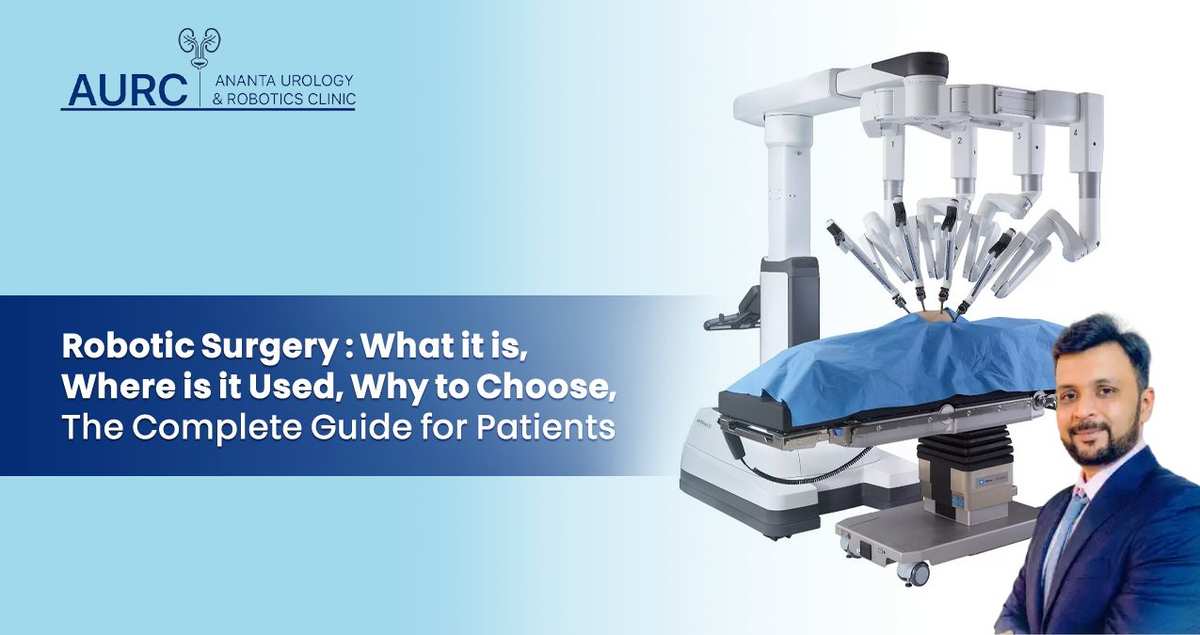
Table of Content:
- What Is Robotic Surgery?
- How is Robotic Surgery Done?
- Why More Patients Are Choosing Robotic Surgery
- Where Robotic Surgery is Used
- Robotic Surgery vs. Laparoscopic Surgery vs Open Surgery: What’s the Difference?
- What to Expect during Robotic Surgery? The Journey from Start to Finish
- What to Do and What Not to Do After Robotic Surgery
- Concerns and Recovery Tips for Robotic Surgery
- Future of Robotic Surgery in India
- Choosing the Right Surgeon and Hospital for Robotic Surgery
- Frequently Asked Questions About Robotic Surgery
As robotic surgery becomes more popular and accessible across the world and India, especially for complex conditions like kidney cancer, prostate cancer, bladder cancer, and even gynaecological issues, many patients are curious about what robotic surgery is and what makes it so different from traditional surgeries. Here’s an in-depth guide covering everything you need to know about robotic surgery from one of the best urooncologist in Ahmedabad, India. We’ll walk you through what it is, how it works, why it’s preferred, what to expect, and how to find the best doctor and hospital for robotic surgery for urology cancer treatment.
What Is Robotic Surgery?
Robotic surgery represents a transformative leap in surgical technology. But what does it actually mean for patients? In the simplest terms, robotic surgery is a minimally invasive technique where a highly skilled robotic surgeon uses advanced robotic surgical systems like Da Vinci to perform precise, complex procedures. Think of the robotic system as a surgical assistant— it doesn’t act independently but instead allows the surgeon to carry out surgical movements with unparalleled accuracy.

How is Robotic Surgery Done?
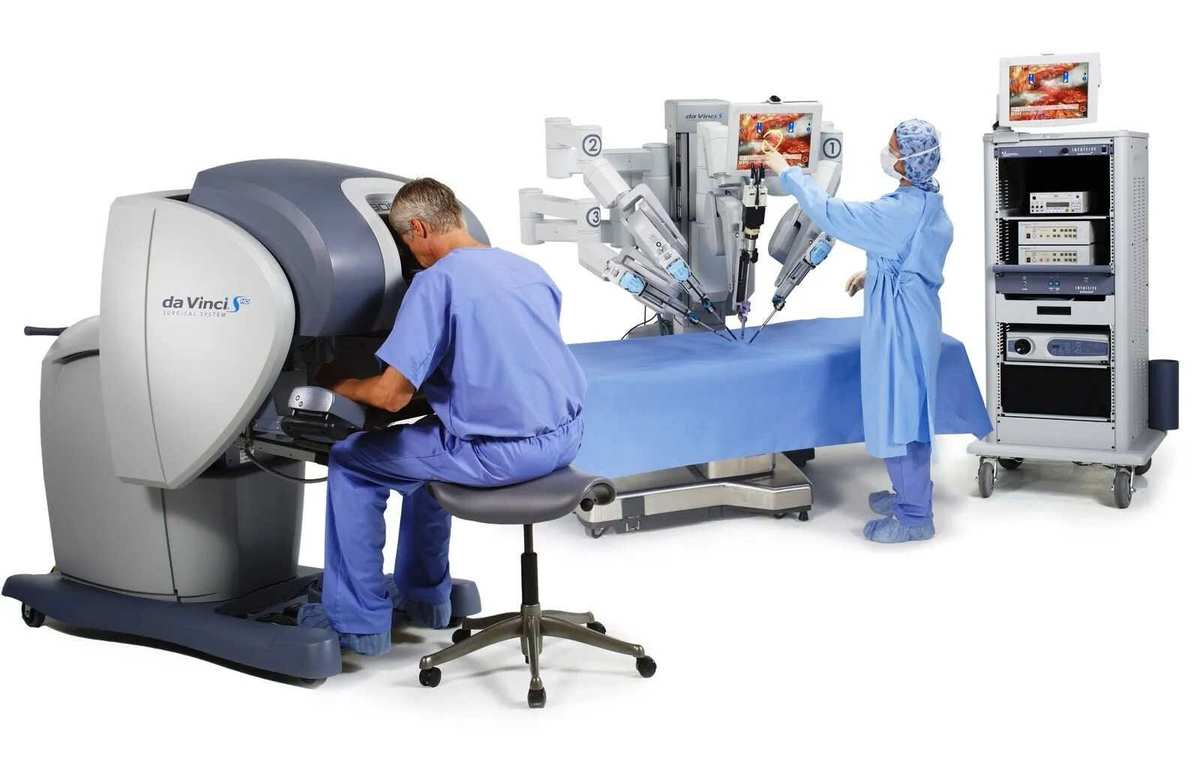
The robotic system consists of a few main parts. As seen in the above image, there’s a console where the uro oncologist surgeon sits and performs the surgery by looking at a 3D picture. Then, there is a patient cart, which has 4 robotic arms. Each arm has miniaturized instruments of 8-10mm that enter the body through the ports introduced through small incisions, along with a high-definition 3D camera for a 10 times magnified view. This setup provides the surgeon with a clearer view of the surgical site than what is possible with the human eye alone.
Why More Patients Are Opting to Undergo Robotic Surgery
Robotic surgery has revolutionized how many procedures are performed, particularly in the field of urology. The technique has been used for more than 20 years, and its benefits are well-documented, with many patients choosing robotic surgery due to its advantages over traditional surgery. Here’s a look at why robotic surgery could be the right choice for you:
1. Surgeon-Controlled Precision
The key advantage of robotic surgery is precision. While traditional surgery involves larger incisions and direct manipulation of organs and tissues, robotic surgery allows the surgeon to operate on a much finer scale. The surgeon’s movements are translated into precise actions by the robotic arms, with zero chance of hand tremors affecting the outcome. This is particularly beneficial in delicate procedures, such as those involving organs like the prostate or kidneys, where precision is crucial.
2. Minimally Invasive
One of the main reasons to opt for robotic surgery is that it is minimally invasive. This means that instead of a large incision, only small keyhole-sized incisions are made. For patients, this is a game-changer because it significantly reduces the trauma to the body, minimizing pain and the risk of complications.
Smaller incisions also mean less scarring. Since robotic systems can use smaller instruments to perform delicate procedures, the incisions remain much smaller than those used in traditional surgery, allowing for faster healing and less visible scarring.
3. Less Pain
Minimally intrusive typically means less pain after the procedure. Robotic surgery uses small tools, which means surgeons don't need to make large cuts. This approach causes less damage to nearby tissues, leading to less discomfort compared to traditional methods. As a result, patients recover more smoothly and often need fewer pain medications, improving their comfort and well-being after surgery.
4. Greater Precision
Robotic surgery allows robotic surgeons to perform procedures with more precision than ever before. The robotic system provides enhanced 3D visualization and magnification of the surgical area, which means that surgeons can see the tissues and organs in much greater detail. This level of precision is crucial, especially for delicate surgeries like prostate cancer or kidney cancer removal, where even a small misstep could have significant consequences.
In addition, robotic systems are designed to eliminate the issue of hand tremors that might affect human hands during traditional surgery. This results in more accurate and controlled movements, reducing the risk of human error.
5. Faster Recovery and Reduced Hospital Stay
Because robotic surgery involves less disruption to the body, patients typically experience faster recovery times. This means less time in the hospital and a quicker return to normal activities. Traditional surgeries often require longer stays in the hospital due to the larger incisions and more invasive procedures. On the other hand, robotic surgery allows for quicker recovery, often allowing patients to leave the hospital the day after the procedure.
6. Lower Risk of Infection
Small incisions made during robotic surgery carry a significantly lower risk of infection than traditional, larger incisions. Infection is one of the major concerns after surgery, but with robotic surgery, the smaller incisions and more precise handling of tissues reduce the chances of post-surgical infection. This is a key advantage, particularly for patients who may have a higher risk of infections due to existing health conditions.
7. Better Surgical Outcomes
According to strategicmarketresearch.com On average robotic surgery has a 95% success rate. This has made robotic surgery a preferred choice in many complex surgeries, including those for prostate cancer, kidney cancer, and bladder cancer.
For patients undergoing surgery for prostate or kidney cancer, robotic surgery for kidney cancer has been associated with higher rates of cancer-free outcomes, as precision and minimal invasiveness improve the surgeon's ability to remove cancerous tissue with greater success.
8. Enhanced Surgeon's Comfort
Robotic surgery is not just beneficial for the patient—it also provides advantages for the surgeon. Unlike traditional surgeries, where the surgeon may have to stand for hours in a fixed position, robotic surgery allows the surgeon to sit comfortably at a console. The robotic arms are controlled with precision from this console, reducing the physical strain on the surgeon. This means the surgeon can focus more on the task at hand and operate with the same level of precision throughout the procedure.
Where Robotic Surgery is Used
Robotic surgery is versatile and is used in a variety of medical specialities, particularly in the fields of urology, oncology, and gynaecology. Here’s a look at some of the conditions that benefit from robotic surgery, particularly in urology:
Prostate Cancer

For those diagnosed with prostate cancer, robotic prostatectomy has become the gold standard. Robotic-assisted prostate removal offers several advantages over traditional surgery, including reduced blood loss, shorter hospital stays, and a faster return to normal activities. This procedure is particularly beneficial for patients with localized prostate cancer, and it offers excellent outcomes in terms of cancer control and reduced risk of complications like incontinence and erectile dysfunction.
Kidney Cancer

Patients with kidney tumors are increasingly opting for robotic partial nephrectomy, a procedure that allows surgeons to remove the tumor while preserving as much of the healthy kidney tissue as possible. This is particularly important for patients who only have one functional kidney or those with early-stage kidney cancer. Robotic surgery allows for precise tumor removal, reducing the risk of recurrence and improving kidney function after the surgery.
Bladder Cancer

For bladder cancer patients requiring a radical cystectomy (removal of the bladder), robotic surgery offers a way to perform this complex procedure with greater accuracy and fewer complications. The robotic technique can also be used to reconstruct the bladder (creating a neobladder) using portions of the intestines, which helps restore normal urinary function. This minimizes trauma and offers a quicker recovery than traditional open surgery.
Robotic Surgery in Gynaecology and Oncology
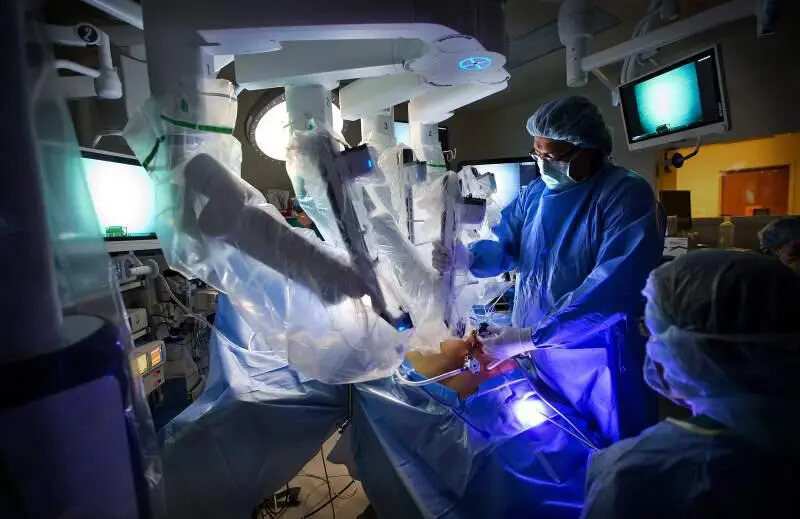
Robotic surgery can also be effective for patients undergoing surgeries for conditions like endometriosis, colorectal cancer, and other complex procedures. Generally, patients who are in good overall health, have no severe heart or lung conditions and are looking for faster recovery times are the best candidates for robotic surgery. If you’re considering robotic surgery, your robotic surgeon in Ahmedabad will conduct a thorough preoperative assessment to determine if this approach is the right one for you.
Robotic Surgery vs. Laparoscopic Surgery vs Open Surgery: What’s the Difference?
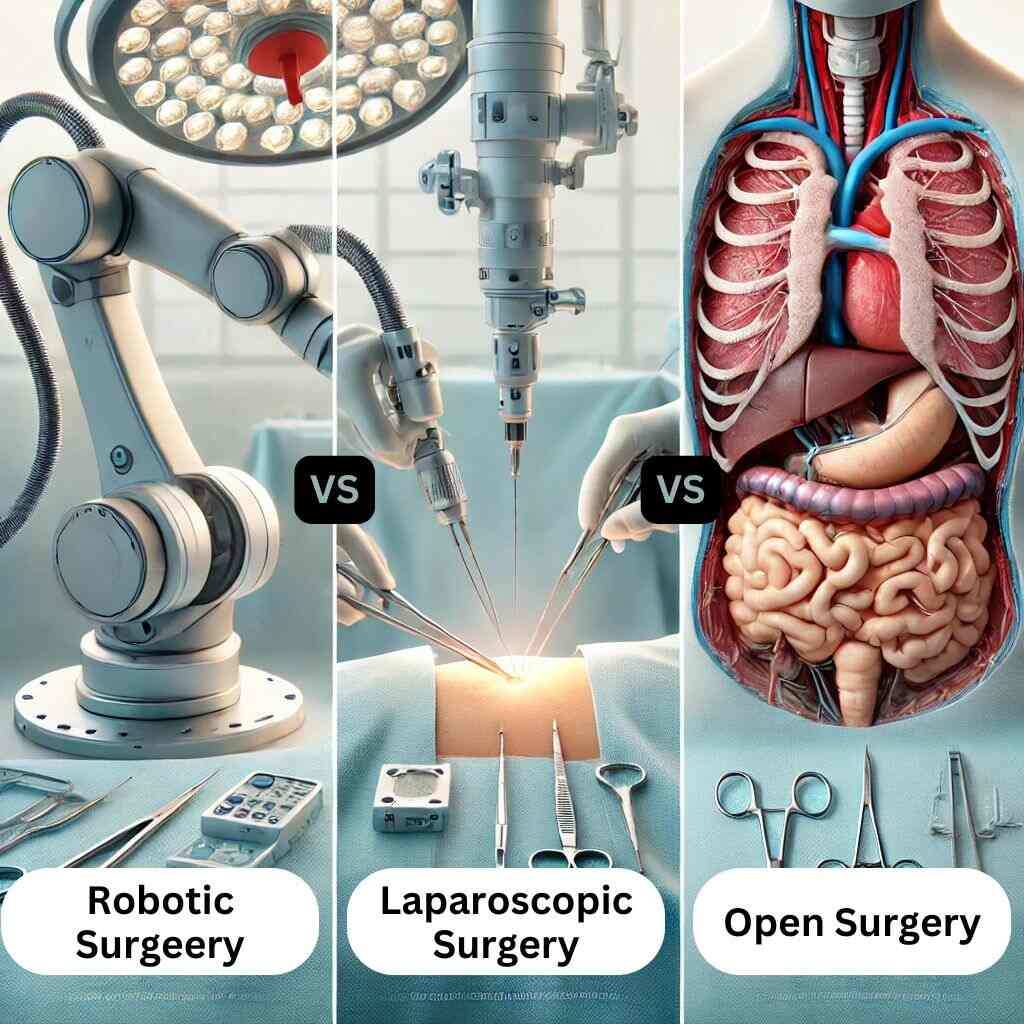
Here’s a quick comparison to help you understand how robotic surgery stacks up:
| Aspect | Open Surgery | Laparoscopic Surgery | Robotic Surgery |
|---|---|---|---|
| Incisions | Large | Small | Tiny, minimally invasive |
| Pain & Recovery | More pain, longer recovery time | Moderate pain, faster recovery | Least pain, fastest recovery |
| Precision | Limited by hand movements | Good control over gross movements | Extremely precise, robotic-controlled |
| Blood Loss | High | Moderate | Minimal, thanks to accuracy |
| Hospital Stay | 5-7 days | 3-4 days | 1-2 days |
What to Expect During Robotic Surgery? The Journey from Start to Finish
What Happens Before, During, and After Robotic Surgery?
Understanding what to expect during each phase of the robotic surgery process can help alleviate any concerns and make the experience as smooth as possible. Here’s a detailed breakdown of what you can expect before, during, and after your robotic surgery.
Preoperative Workup and Consultation

Before undergoing robotic surgery, you will have a consultation with your uro oncologist or robotic surgeon. During this consultation, the surgeon will review your medical history, conduct a physical exam, and discuss your treatment options. You may undergo various tests to ensure you are in good health for surgery. These could include blood tests, imaging scans (such as CT or MRI), and a physical evaluation of your kidneys, bladder, or prostate, depending on your condition.
Once your surgeon has reviewed your results, they will explain the robotic procedure in detail, answer your questions, and discuss any potential risks or benefits. Your surgeon will also give you clear instructions on how to prepare for surgery, which may include stopping certain medications, fasting before the procedure, and arranging for post-surgical care.
Day Before Surgery
On the day before surgery, you will be asked to follow certain instructions provided by your surgical team. These could include:
- Fasting: You will likely be instructed to refrain from eating or drinking for 4 to 6 hours before the surgery to ensure that your stomach is empty during the procedure.
- Medication: You may be asked to stop taking certain medications, especially blood thinners or any medications that can affect blood clotting.
- Preoperative Checklist: Depending on the surgery, you may need to use an antiseptic solution to wash your body before the surgery to reduce the risk of infection.
This is also a good time to ask any final questions you might have about the procedure and recovery process.
On the Day of Surgery
On the day of the surgery, you will arrive at the hospital or surgical centre. A member of your surgical team will review your medical history and surgical plan one last time. Then, you will be taken to the preoperative area, where you’ll change into a surgical gown. You will be hooked up to monitors that will track your heart rate, blood pressure, and oxygen levels during the surgery.
The anaesthesia team will administer general anaesthesia, ensuring that you are asleep and pain-free throughout the procedure. The robotic surgeon will then make several small incisions in your abdomen or pelvic area, through which they will insert robotic arms and instruments.
Once the robotic system is activated, the surgeon will operate from a console, controlling the robotic arms with extreme precision. Thanks to the enhanced 3D imaging and magnified view of the surgical area, the surgeon can remove or treat the affected tissue with greater accuracy than in traditional surgery. The duration of the surgery will depend on the complexity of the procedure but typically lasts between 2 to 5 hours.
Post-operative Day 0, 1, and 2
After the surgery, you will be taken to the recovery room, where you will be closely monitored. The first 24 hours are crucial for monitoring your vital signs, ensuring the anaesthesia wears off, and observing any complications. You may experience some mild discomfort, but pain management will be provided to keep you comfortable.
Day 1: By the first day after surgery, you will be encouraged to sit up and try walking a few steps. While this may seem like a small step, early movement promotes faster recovery and helps prevent complications like blood clots. You may also be given breathing exercises and a spirometer to help improve lung function and prevent pneumonia.
Day 2: By day two, you will likely be able to move around more and be on a light diet. Most patients are able to leave the hospital within 1 to 2 days after surgery, though this depends on your specific condition and progress.
Post-operative Weeks 1 to 4
The first few weeks after robotic surgery are crucial for recovery. During the first week, you will be advised to avoid strenuous activities and heavy lifting. You should focus on light walking, which will help speed up recovery and improve circulation.
During weeks 2 to 4, you will gradually resume your normal activities, but you should avoid intense physical exertion. You may have follow-up appointments with your uro oncologist or robotic surgeon to assess your recovery, remove any drains or catheters, and discuss the next steps in your treatment.
What to Do and What Not to Do After Robotic Surgery
To ensure optimal healing, follow your doctor’s instructions carefully. Here are a few general dos and don'ts:
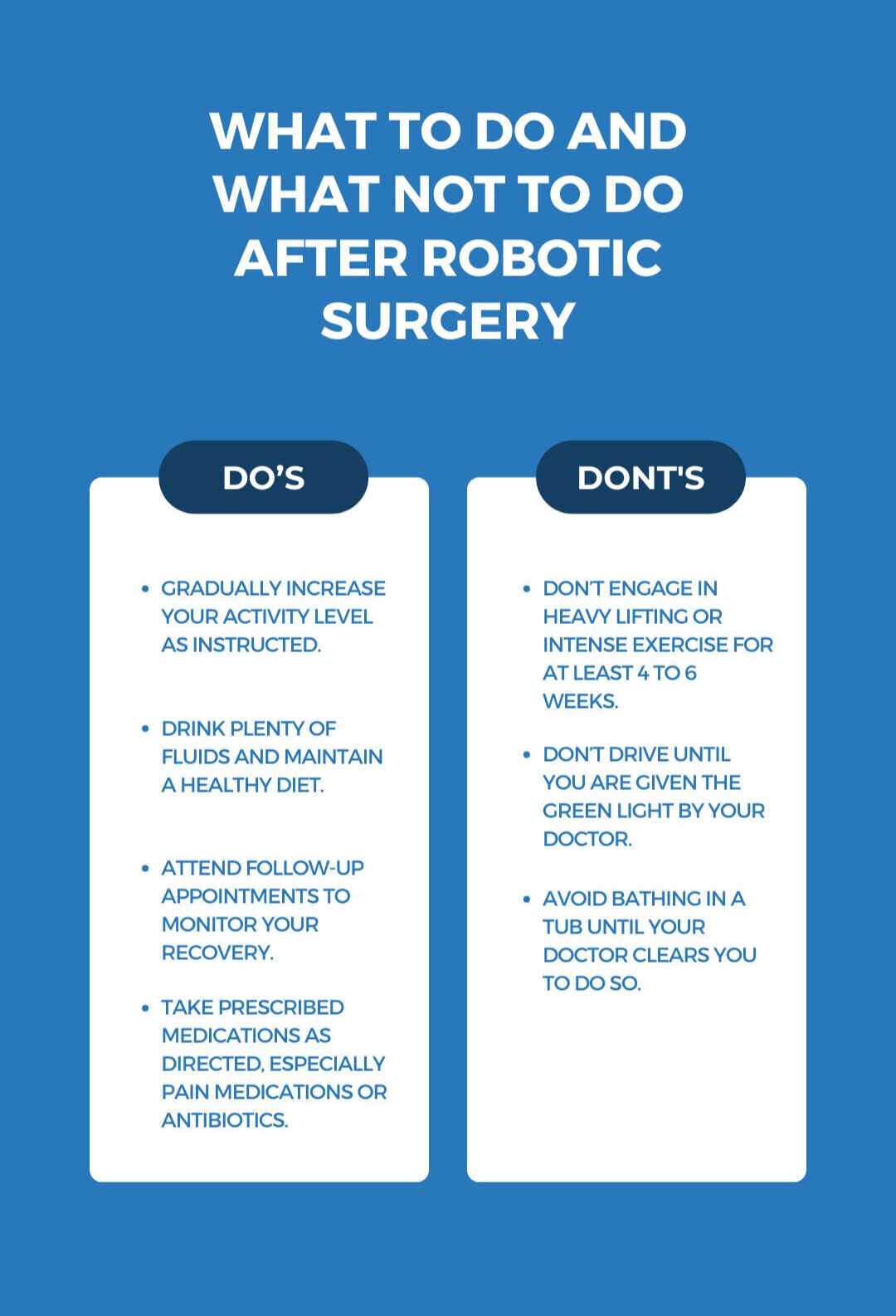
Concerns and Recovery Tips for Robotic Surgery
Every patient has a few questions before surgery. Here are some of the common ones and tips to help you recover well:
- Is robotic surgery painful? Minimal and manageable with medication.
- Will There Be Scars? Just tiny ones, thanks to the small incisions.
- What About Blood Clots? Walking regularly after surgery helps prevent them.
- Issues with Urine or Bowel Function? Some procedures (like prostatectomy) might affect these temporarily.
Recovery Tips
- Move Around: Even gentle movement boosts circulation.
- Stay on Top of Follow-Ups: These visits help track your progress.
- Healthy Eating: A balanced diet supports healing.
Future of Robotic Surgery in India
Looking ahead, the future of robotic surgery in India is bright. With AI-assisted systems, we’re seeing even more accuracy, accessibility, and perhaps even telesurgery on the horizon! This means even better outcomes and access for urology cancer patients across India.
Choosing the Right Surgeon and Hospital for Robotic Surgery
If you're considering robotic surgery in Ahmedabad or India, selecting the right surgeon and hospital is crucial for a successful outcome. Here are key factors to consider to ensure you get the best care possible.
Surgeon’s Experience:
Choosing a qualified robotic surgeon is one of the most important steps in ensuring a successful surgery. Look for a surgeon who is a certified robotic surgeon and ideally specializes in the field relevant to your condition. For example, if you are undergoing kidney cancer surgery, choosing an uro oncologist with extensive experience in robotic partial nephrectomy or robotic radical nephrectomy is key to the procedure's success.
Experience matters because robotic surgery requires a surgeon to have not only technical expertise but also the ability to handle unexpected situations that may arise during surgery. Surgeons with a proven track record of performing successful robotic procedures will provide you with a higher level of confidence and a greater chance for a smooth recovery.
Top-Rated Robotic Surgery Hospitals in India:
When choosing a hospital for robotic surgery, it’s important to look for top-rated hospitals with qualified robotic surgeon that are equipped with the latest technology and have a specialized team to support you throughout your treatment journey. In Ahmedabad and Gujarat, many leading hospitals now offer robotic-assisted surgery, such as robotic prostatectomy, robotic cystectomy, and robotic nephrectomy.
Check whether the hospital has:
- State-of-the-art robotic systems: Hospitals with the latest da Vinci robots or other advanced surgical systems are better equipped to handle your procedure.
- Dedicated robotic surgery team: A multidisciplinary team, including robotic surgeons, anesthesiologists, nurses, and other specialists, can ensure that your surgery is as safe and effective as possible. At Ananta Urology & Robotics Clinic, we have a dedicated and qualified team.
- Comprehensive post-surgery care: The best hospitals will offer post-operative support with clear follow-up schedules, physical therapy, and recovery monitoring.
Patient Reviews and Feedback:
One of the best ways to gauge the quality of care provided by a surgeon or hospital is through patient reviews. Look for hospitals with positive feedback from past patients, especially those who have undergone robotic surgery. Patient testimonials can give you insight into what you can expect during your own experience, from the consultation process to post-surgery recovery.
It’s also helpful to reach out to people who have had similar procedures. Many hospitals provide opportunities for patients to connect with others who have undergone the same type of surgery, so you can ask questions and hear firsthand about their experiences.
Finding the Right Robotic Surgeon for You:
It’s important to consult with a few robotic surgeons before making your decision. During your consultation, ask the following questions:
- How many robotic surgeries have you performed for my condition?
- What is your complication rate with robotic surgery?
- What kind of post-surgical care and support do you provide?
- Can I meet with a member of your team to discuss recovery and rehabilitation?
Choosing the right surgeon and hospital for robotic surgery can significantly affect your surgical outcomes and your overall experience. By doing thorough research and seeking a hospital with a dedicated robotic surgery team, you are investing in your health and ensuring you receive the best possible care.
Conclusion
Robotic surgery is revolutionizing medical care in India, offering precision, minimal invasiveness, and faster recovery times. For patients in Ahmedabad, Gujarat, or anywhere in India, choosing the right robotic surgeon and hospital can make a world of difference. If you’re considering robotic surgery for kidney cancer, bladder cancer, prostate cancer, or gynaecological conditions, speak with Dr. Rohan Patel, Top UroOncologist & Robotic Surgeon in Ahmedabad India, at Apollo Hospital to get all your questions answered and determine the best path for your care.
Frequently Asked Questions About Robotic Surgery
Yes, robotic surgery is very safe when performed by an experienced, certified robotic surgeon. The precision and minimally invasive nature of robotic surgery contribute to fewer complications, faster recovery times, and a reduction in hospital stays compared to traditional open surgery. However, as with any surgery, there are risks, so it's important to choose a qualified robotic surgeon with extensive experience.
Recovery after robotic surgery is typically faster than traditional surgery. Most patients resume their normal activities within 1 week. However, full recovery can take a few weeks, especially if you’ve had a major procedure like robotic cystectomy or robotic nephrectomy. Your surgeon will provide you with specific recovery timelines and guidelines based on your procedure and health.
Insurance coverage for robotic surgery varies depending on the insurer and the specifics of the procedure. Many insurance providers in India now cover robotic-assisted surgeries, as they are recognized as a standard medical treatment. It's best to check directly with your insurance provider or hospital to understand the coverage for robotic surgeries and any out-of-pocket expenses you may need to plan for.
Most patients who are candidates for traditional surgery are also eligible for robotic surgery, provided they are in good overall health and have no contraindications. Your robotic surgeon will assess whether robotic surgery is the right option for you based on your condition, medical history, and other factors. Conditions like kidney cancer, bladder cancer, prostate cancer, and benign prostatic hyperplasia (BPH) are commonly treated with robotic-assisted techniques.

